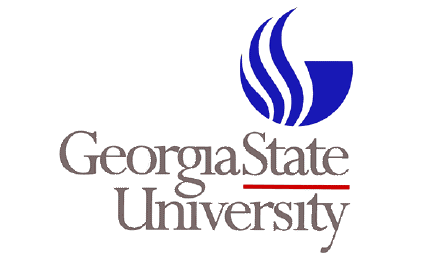 Department of Physics and Astronomy
Department of Physics and Astronomy
PHYS 3850/7850
STATISTICAL AND THERMAL
PHYSICS
Fall Semester 2012
| Class |
5:30
pm
- 6:45 pm |
MW |
Natural
Science
Center 272 |
Jan
09, 2012 - April 30, 2012 |
Instructor: Mark Stockman
Office: 406 Science Annex
(by appointment)
Phone: (678)457-4739 (worldwide mobile)
E-mail: mstockman@gsu.edu
Web site: http://www.phy-astr.gsu.edu/stockman/
Grading: 30% midterm exam, 70% final exam (subject to change)
Final Exam:
Monday, April 30 from 4:15 pm to 6:45 pm in the
regular classroom
Text: Roger Bowley and Mariana Sanchez, Introductory
Statistical
Mechanics, Oxford University Press, Oxford, New York, 1999 or later.
Basic Rules of the Class Room
These rules are designed to allow
students to get the maximum benefit
for
their time and money spent.
The physical attendance of lectures is not required but strongly
recommended.
If you happen to be late, enter class, do not apologize, quietly
take
your
seat and start working. If you need to leave, do so also as
quietly as
possible, do not ask permission. Timely submission of home
assignments
is required. The home assignments are due in one week after they
are
given. They will not be graded but you will be given detailed
solutions
in writing, and you will be welcome to discuss them either in
class or
at the office.
Do not talk in class even in a low voice since it is
disruptive
(asking a fellow student a brief question is admissible, but
should be
kept to the minimum). Do not hesitate to interrupt the lecturer
with
any
questions or comment, since it is beneficial for the class. (Do
not
assume
that your question is too trivial to ask -- it may well be not so
trivial.
Many students may have a similar problem. No questions and
comments in
class will affect your grades in any way. Please, your question is very important -- ask
it!)
At the exams, you may not use any notes or books, unless
specifically
allowed. You may briefly (for not more than five minutes) leave
the
class
room after one hour of work without asking permission. You should
bring
your calculator (no data banks) and pen or pencils. The paper
needed
will
be given to you. The date and time of the final exam cannot be
changed.
SYLLABUS
1. Thermodynamics: Introduction and the First Law
- Definitions
- Macroscopic and microscopic description
- Partitions (walls): adiabatic vs. diathermal,
rigid vs.
flexible,
etc.
- Equilibria and principal possibility of a process in
thermodynamics
- Internal energy, work and heat.
- Perfect and imperfect differentials
- Isothermal and adiabatic processes
- Carnot cycle
2. Entropy and the Second Law
- The Second Law
- Carnot theorem.
- Entropy as a function of state
- Entropy and the Second Law
- Maximum of entropy and equilibrium.
- Fundamental relations. Entropy of ideal gas.
- Energy and enthalpy (heat function)
- Van der Waals fluid.
- Mixing ideal gases. Entropy of mixture.
- Joule process (expansion into vacuum)
- Maximum work theorem.
- Equilibria and maximum of entropy
- Thermodynamic identities.
Maxwell
identities. Reduction
of derivatives, method of Jacobians.
3. Introduction to Statistics
- Probability: intuitive and axiomatic formulations
- Independent and mutually excluding events
- Combinatorial probability: Arrangements, permutations, and
combinations
- Distributions
4. Introduction to Statistical Mechanics
- Statistical expression for entropy (Boltzmann, S=kB Log W )
- Entropy of spins on a lattice
- Entropy for vacancies in a crystal
- The second law and thermodynamic fluctuations
5. Gibbs Method: Canonical Ensemble
- Entropy and the number of available sates for an isolated
system
(microcanonical
ensemble). Microcanonical distribution.
- System in contact with thermal reservoir. Entropy and
Gibbs
distribution.
- Alternative way to derive the Gibbs distribution:
Principle of
maximum
disorder
- Boltzmann formula for entropy
- Partition function. Helmholtz free energy and
thermodynamics.
- Two-level system
- Monatomic ideal gas.
- Rotational and vibrational contributions.
- Equipartition
- Thermodynamic equilibria and minima of potentials
- Einstein and Debye heat capacity.*
6-8. Identical particles
- Identical particles in quantum mechanics.
- Pauli theorem on spin and statistics. Fermi-Dirac and
Bose-Einstein
statistics.
- Molecule with identical atoms
- Classical ideal gas and Maxwell distribution
- Black body radiation (photon gas) and Planck distribution.
- Thermodynamics of the photon gas.
- Einstein and Debye heat capacity of solids
9,10. Gibbs method: Grand Canonical Ensemble
- Chemical equilibria and chemical potentials
- Grand canonical ensemble and the grand canonical potential
(or,
grand
potential).
- Fermi gas. Grand partition function. Fermi distribution
and
Fermi
energy.
- Thermodynamic properties at T=0 and T<<EF.
- Application to astrophysics.
Equilibria
of
stars.*
- Bose systems. Bose condensation.
- Black body radiation revisited. Photons and Planck
distribution.
4. Dielectric and magnetic systems*
- Polarization and electrostatic
energy.*
- Dielectrics with fixed external
potentials.
Free
energy of dielectrics.*
- Microscopic models of dielectrics.
Rigid
and induced
dipoles.*
- Thomas-Fermi approximation for
interacting
electron
gas. Debye screening. Plasmons.*
- Thermodynamics of magnetics.
- Pauli paramagnetism and Landau
diamagnetism. Quantum
oscillations.*
*) Time permitting (usually not taught
unless the students express specific and significant interest)
